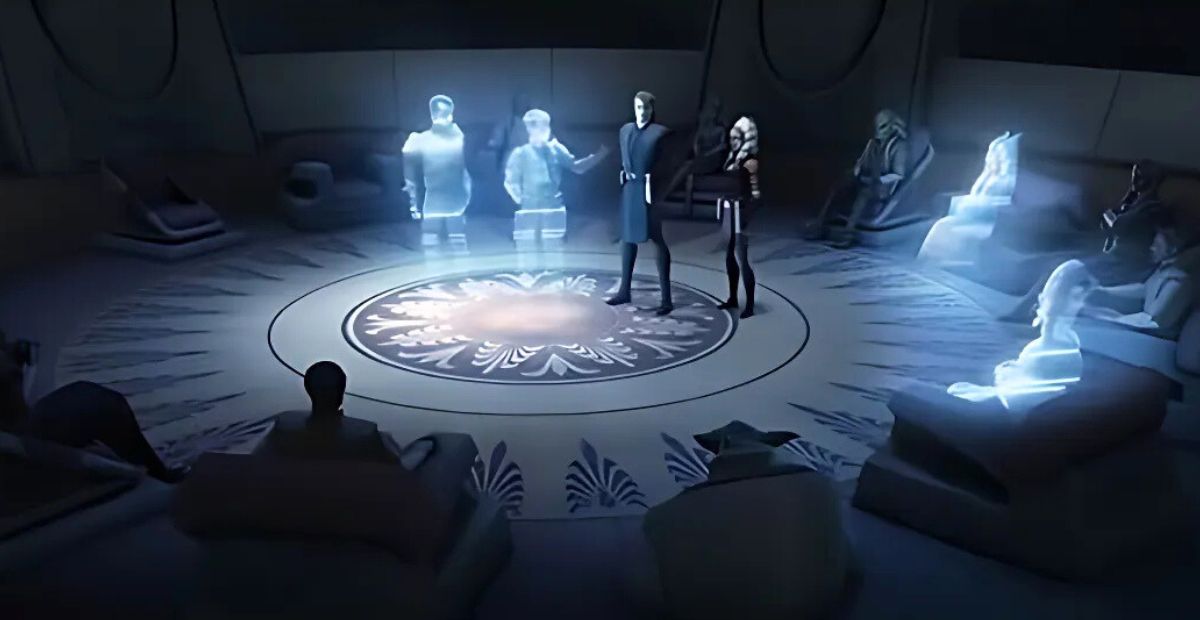Have you ever noticed how the Jedi Council kept themselves firmly rooted in strategy and oversight instead of getting their hands dirty in the Clone Wars?
It’s almost like they spent more time discussing the rules than acting on the pressing needs of their own Jedi in the field.
By focusing on their own lofty ideals, they often left Anakin, Ahsoka, and Obi-Wan to handle the biggest battles and decisions with little guidance or backup.
The Alienation of Anakin Skywalker
While the Council stayed behind, contemplating their role and the Republic’s future, Anakin was taking massive risks to keep their armies moving forward.
This wasn’t just a “lead from behind” approach—it sent a message.
The Council was so focused on staying detached and above the conflict that they forgot to support their own Jedi, and it’s no wonder Anakin began questioning their priorities.
The “Citadel Rescue” arc in The Clone Wars is a perfect snapshot of Anakin’s rocky relationship with the Jedi Council.
The mission to infiltrate the Citadel on Lola Sayu showcases Anakin and his team tackling severe challenges—outdated intel, grueling conditions, and life-threatening obstacles—all while the Council sits back, relying on standard orders and distant oversight.
Anakin’s plan to use carbonite freezing to sneak past life sensors is brilliant, yet the Council rarely gives credit to his risky, effective ideas.
Throughout the mission, Ahsoka plays a key role, stepping up when things go south despite the Council’s tendency to shelter younger Jedi from such dangers.
This arc makes Anakin’s frustrations with the Council relatable; they seem detached, too focused on protocols to appreciate the realities he and his team face on the ground.
In the end, it’s clear how the Council’s bureaucratic distance and lack of trust only deepen Anakin’s sense of isolation, adding fuel to his doubts and paving the way for his eventual disillusionment with the Jedi Order.
How the Jedi Council Left Ahsoka Solo at the Siege of Mandalore
During the Siege of Mandalore arc in The Clone Wars, we see the Jedi Council’s approach to supporting Ahsoka on full display—and it’s a little lacking, to say the least.
Despite the fact that Ahsoka was no longer an official Jedi, the Council handed her the responsibility of liberating Mandalore from Maul with minimal support.
Although Anakin and Obi-Wan briefly connect with her at the start, they’re quickly reassigned to help with the Chancellor’s capture on Coruscant, leaving Ahsoka to face Mandalore’s occupation and Maul’s forces essentially solo.
What stands out here is the Council’s prioritization of other missions, almost as if Mandalore’s liberation was an afterthought.
Ahsoka, equipped with only a small clone detachment under Captain Rex, goes head-to-head with Maul’s powerful Shadow Collective.
The scale and importance of the mission—aimed at capturing a notorious Sith who had destabilized Mandalore—would have justified far more support.
But instead, the Council entrusted Ahsoka with a massive burden, one that highlighted their habit of keeping Jedi like Anakin, Ahsoka, and Obi-Wan at arm’s length while not fully investing in them.
This decision reveals the Council’s strategic blind spots and a pattern of detachment that ultimately leaves their strongest warriors feeling isolated and undervalued.
Anakin and Obi-Wan’s Battle Without Council Support
At the Battle of Ryloth, Anakin and Obi-Wan showed the intense pressure the Jedi generals faced on the front lines, especially with limited support from the Council.
The planet Ryloth was a critical target for the Republic. If the Separatists held it, they’d gain a crucial edge in the region. Anakin and Obi-Wan were leading the charge, navigating both heavy droid forces and the task of coordinating with local Twi’lek freedom fighters.
Their job was to free the planet and ensure the Twi’lek people’s survival, which was no small task.
Despite the importance of Ryloth, the Council provided limited reinforcements and stayed at a distance, only stepping in after Anakin and Obi-Wan had exhausted their initial resources.
This hesitation on the Council’s part left Anakin and Obi-Wan, along with their clone forces, to bear the brunt of the campaign.
The situation eventually escalated to the point where they could hardly manage it alone, and by then, the stakes had already grown critical.
This approach of giving broad directives while staying removed from the action was typical of the Jedi Council.
It reflected their preference for strategic detachment, even if it left their generals in near-impossible situations.
The Council’s reluctance to directly engage, even when critical missions were at stake, became a hallmark of their leadership style and a recurring challenge for Anakin, Obi-Wan, and the rest of the Jedi on the ground.

